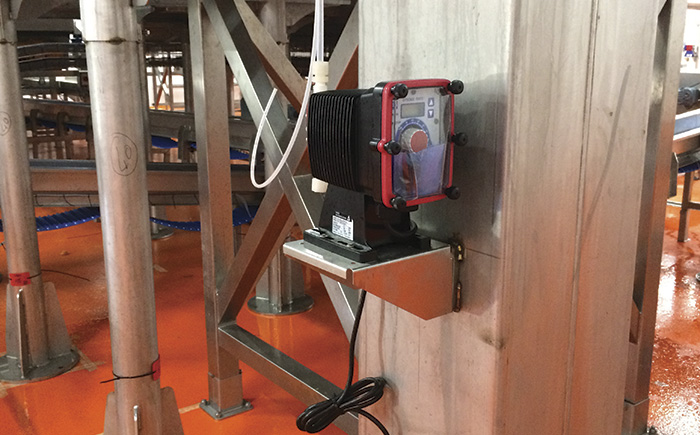Choosing the correct metering pump involves many considerations. Among them are accuracy, repeatability, chemical output, material compatibility, line pressure, control input, off-gassing of the chemical and the environment where the pump will be placed. Even for pumps that meet the requirements for a particular application, the environment in which the pump operates can pose a significant challenge. Metering pumps often are used in wet conditions and require daily washdowns of the equipment.
 Image 1. An example of a metering pump installation (Images courtesy of the author)
Image 1. An example of a metering pump installation (Images courtesy of the author)Water Intrusion
Manufacturing a food or beverage—as well as maintaining a hygienic work area during the process—requires copious amounts of water. Washing down the equipment requires either raw water or water containing chemicals such as oxidants. The inundation of water during the washdown process frequently causes pump failure because of water intrusion into the electrical drive or control. Repairing these pumps is time-consuming and requires a replacement pump to keep the line producing. If the pump is replaced, the new equipment also faces the risk of failure because it operates in the same environmental conditions. In some cases, end users replace these pumps with a waterproof version that can handle the washdown procedures. There are pumps available with a rating of Ingress Protection (IP) 67 (NEMA 6 equivalent), which means they were tested under 3 feet of water for 30 minutes and continued to run properly. For example, one manufacturer’s line of these types of metering pumps have been used extensively in the produce disinfection market where washdowns, condensation from low temperatures and perpetually wet surfaces exist. In this specific example, these pumps also can be used in many environments and processes where water intrusion, flooding or washdowns occur.IP 67 Pump Benefits
Chemical metering pumps are the workhorse in produce applications because all produce must be disinfected to remove or kill disease-causing pathogens. The process typically requires an oxidizing disinfectant such as chlorine, chlorine dioxide or peracetic acid to be pumped into the water that comes into contact with the produce. The residual oxidant must be maintained during the process for the required contact time to ensure that the microorganisms are killed and cannot reproduce. This usually requires an accurate, reliable and waterproof chemical metering pump in conjunction with a controller and an appropriate chemical sensor. The produce disinfection process places pressure on chemical pumps because of the constantly wet environment. Several tools and accessories can protect these pumps, but they often pose their own challenges. Pump covers, for example, can make the pump difficult to access for adjustment or servicing. Pump boxes also make pump adjustments difficult, and they can contain heat, which may cause a heat overload or failure..jpg) Image 2. Metering pumps installed in a facility
Image 2. Metering pumps installed in a facilityOther Pump Considerations
There are other important installation points users must consider to ensure that these pumps work as specified. When pumping an oxidant that off-gasses, it is important to install an auto-degassing valve. This valve purges gases from the pump head through a low-pressure line so that the pump does not lose prime because of a vapor lock. The purge line returns to the chemical tank. Vapor lock occurs because gas is compressible and liquid is not. When the pump is unable to purge the gas, the gas in the head is continually compressed and decompressed, so no liquid moves through the lines. It is always advisable to have the shortest suction line possible, so gas cannot accumulate. This will reduce the time required for the pump to purge the gas from the tubing, which will help keep the chemical residual consistent. The pump also may be outfitted with a chemical feed verification device that will alert end users to the loss of chemical feed from the pump. The device sends a signal to a controller or programmable logic controller with an alarm when this deviation occurs.Produce Disinfection
Pulse Instruments, a California company that specializes in produce disinfection nationwide, has used a specific type of metering pump in many of its accounts over the last six years, significantly reducing the number of pump failures. Previously, Pulse Instruments had encountered issues with water intrusion in its equipment. When the pumps failed, the process lines had to be shut down, and sometimes produce needed to be discarded. The specific type of metering pump the company chose did not fail and has reduced downtime and maintenance in the plants. The pumps require low maintenance and need to be serviced every two years. The servicing only requires a change of the wetted parts that come into contact with the chemical, such as the diaphragm, seats and ball checks. This procedure can be performed in about 15 minutes. The selected pump “has given us superior performance and reliability,” said Ben Vogt, national technical support manager for Pulse Instruments and Aqua-Pulse Systems. “With the IP 67 waterproof rating and wide range of dosing capabilities, the pump can be utilized in a variety of environments and applications.”The definition of IP 67, according to The Siemon Company1
Enclosures constructed for either indoor or outdoor use to provide a degree of protection to personnel against incidental contact with the enclosed equipment; to provide a degree of protection against falling dirt; against hose-directed water and the entry of water during occasional temporary submersion at a limited depth; and that will be undamaged by the external formation of ice on the enclosure.
6 = Totally protected against dust
7 = Protected against the effects of temporary immersion between 15 cm and 1 m. Duration of test 30 minutes.
References
1. siemon.com/us/standards/nema_comparison.asp

